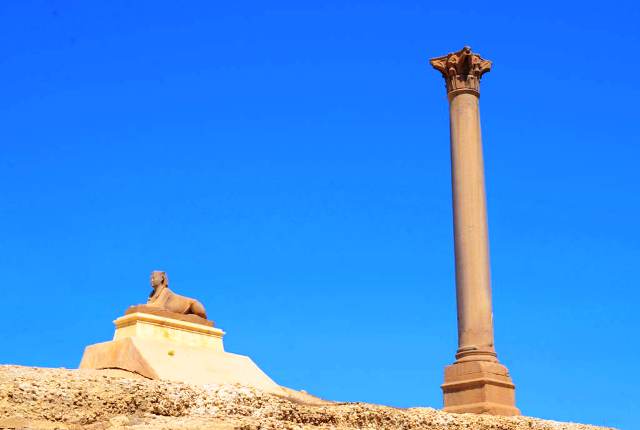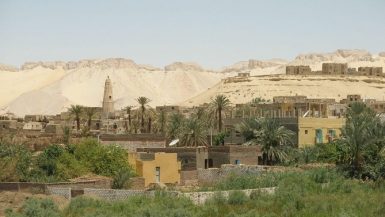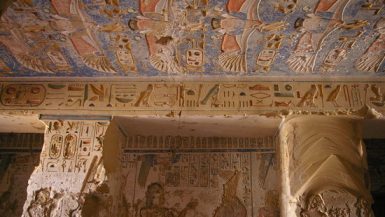A major restoration project of the site of Pompeys Pillar in Alexandria was recently completed by the Supreme Council of Antiquities.
It is now an impressive open museum and one of the finest archaeological examples of the Greco-Roman Period in Egyptian history.
Pompeys Pillar itself stands at the top of a hill in the oldest part of the city of Alexandria. Once the site of an ancient Egyptian village called Rhakotis, the area became known during Ptolemaic times as the “Alexandria Acropolis.”
Pompeys Pillar : Alexandria Acropolis
Pompeys Pillar remains its primary landmark at an impressive height of approximately 27 meters. It is made of red granite, quarried and transported from Aswan in Upper Egypt, and is flanked by two sphinx statues.
Contrary to popular belief, the pillar did not belong to the great Roman leader, Pompey, but was erected during the Greco-Roman period by the people of Alexandria to honor the Emperor Diocletian.
An inscription on the pillar reads: “To the right and good emperor, the protector god of Alexandria, Diocletian, who has never been beaten. Therefore Postumus constructed this pillar.”
Legend has it, however, that when Pompey was defeated by Julius Caesar and escaped Rome for Egypt, only to be killed in Alexandria, his head was placed in a funerary jar on top of the pillar’s capital, thus earning the monument its famous name.
Pompeys pillar Facts
Pompeys pillar stands in the center of the temple hall of the Serapeum, the principal temple of the Greco-Egyptian god Serapis, personified by the sacred Apis bull.
The foundations of this temple survive, along with bilingual texts, dating construction of the temple to Ptolemy III Euergetes. A renovation was performed on the temple in approximately 200 AD, remains of which are still standing.
The Serapeum also housed an underground library, contemporary to the ancient library of Alexandria.
This crypt-like structure, approximately 75 meters in length, running beneath the grounds of Pompeys pillar, is still well-preserved, with niches in the walls once reserved for papyri scrolls.
The library is accessed from a staircase leading from the top of the hill to the lower-level ground.
The site of the Alexandria Acropolis also features a “Nilometer.” By means of the Shidia canal, which connected the Nile River to Lake Mariut, the Nilometer was used for measuring the height of the Nile during each flooding season.
Pompeys Pillar Location and Directions
LOCATION: Alexandria
BY BUS or TRAIN: Buses and trains run regularly from Cairo and surrounding major cities to Alexandria.
BY TAXI: Within Alexandria, ask for el aamoud es-sawary, the Arabic name for Pompeys Pillar.
BY FOOT: Walk west from Misr Train Station in Midan Gomhuriyya, and follow the tram tracks into a market. From here the pillar is visible.
Ticket Costs
HOURS OF OPERATION: Open daily. 8 AM – 5 PM
TICKET COST:
Egyptian: 20 LE
Foreign: 150 LE
50% reduction for bearers of International Student ID Card
Pompeys Pillar Facilities
Bathrooms are available on the site in the visitor’s center. Facilities may also be found in town, just outside of the site proper. Street vendors sell food in the nearby market.






Leave a reply